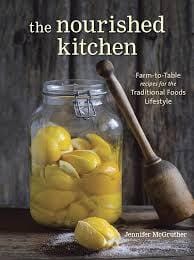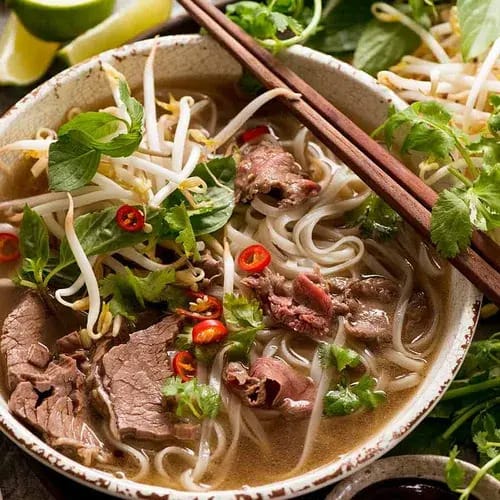- Wylder Space Inc.
- Posts
- The Woman Who Sparked a Real Food Revival: Jenny McGruther & The Nourished Kitchen
The Woman Who Sparked a Real Food Revival: Jenny McGruther & The Nourished Kitchen
Rediscover ancestral cooking, slow food, and the traditional skills of heritage cooking with one of the most influential voices in the movement.
What’s up you beautiful peeps?
Quick heads-up: we’re moving our publication to Substack. It keeps everything in one tidy kitchen corner with newsletters, blogs, live video, and community chat—so you can follow along in any way that suits you (listening, reading or watching).
This week on Sovereign Kitchen Society, I sat down with Jenny McGruther of Nourished Kitchen—one of the voices who helped spark today’s real food revival. We talk practical food sovereignty at home: simple, repeatable habits, building relationships with local farmers, and stocking a pantry that supports family dinners.
Inside the episode you’ll learn:
A beginner’s roadmap to a well stocked pantry
How to learn the basics of broths, sourdough, and ferments without it feeling daunting.
What “ancestral eating” looks like at Jenny’s house :)
Two things you can do to support this movement:
Follow us on substack so you never miss an episode, blog post or recipe
If the convo with Jenny served you, please leave a quick review for the podcast—ratings and reviews help more families find this work: Leave a review on Apple Podcasts / Spotify
Who is Jenny McGruther and her influence in the REAL food movement.
Jenny McGruther is a nutritional therapist, herbalist, writer, and the creative spirit behind Nourished Kitchen - a hub for those who long to cook, eat, and live in harmony with tradition, season, and health.
Her work bridges ancestral wisdom and modern day life: she teaches slow cooking, fermentation, broths, sourdough, herbal remedies, and other traditional techniques — so we may reclaim our health while building a relationship with the soil.

Jenny has authored three major cookbooks, each of which has become a staple for home cooks who want depth, clear recipes and inspiration for their own family dinners.
The Nourished Kitchen — her flagship work, which explores seasonal whole foods, local sourcing, fermentation, sourdough, and traditional preparation.
Broth & Stock — a deep, loving guide to slow-simmered broths, stocks, soups and how they form the backbone of nourishing meals.
Vibrant Botanicals — a book that trains us to cook (and live) with herbs and plants in a way that’s both culinary and medicinal.
Her influence in the real food, food sovereignty, and traditional cooking realms
Jenny holds a respected place in the modern real food movement. Early on, her blog and recipes were among the pioneering voices showing that heritage cooking, ferments, and nutrient-dense methods could be both beautiful and practical. Her work has been picked up by major media and press (Guardian, NPR, Washington Post, New York Times among them) — which speaks to how her message has resonated beyond niche “real food” circles.
For many cooks (myself included), healers, authors, and homesteaders, Jenny is a mentor-from-afar: someone who shows that you can live by real food ideals (fermentation, local sourcing, herbalism) and create art and beauty in the process.
RECIPE O’ THE WEEK
Below: a steaming bowl of pho to feed your family this week—silky, mineral-rich bone broth infused with cardamom, cinnamon, and clove. This dish is truly all about the broth- simmered low and slow for up to 12 hours, it’s deep, savory and mildly sweet, with warming spices permeating every sip from the bowl.

Traditional Pho (makes ~4–5 quarts)
6–7 lb beef bones (mix of knuckles, marrow bones, oxtail; include a beef foot if possible)
6–7 qt cold water
2 Tbsp raw apple cider vinegar
2 carrots, left whole
3 stalks of celery, left whole, leaves still on
2 large onions, halved (leave skins on for color)
4-inch piece fresh ginger, halved lengthwise
2 cinnamon sticks
1 Tbsp coriander seeds
1 Tbsp fennel seeds
6 whole star anise
6 whole cloves
1 black cardamom pod (optional but fabulous in this dish)
1½ Tbsp maldon sea salt, plus more to taste
¼ cup traditional fish sauce
1 Tbsp raw honey, to balance
Optional, extra-mineral boost: 1 strip kombu (add during the last hour; remove before it boils to prevent bitterness)
For Assembly
1 lb banh pho (rice noodles), fresh or dried
8 oz eye of round, sirloin, or tri-tip, sliced paper-thin across the grain (freeze meat 15–20 min for easier slicing)
¼ cup paper-thin sliced onions
¼ cup chopped cilantro leaves
Traditional + Cultured Toppings
Fresh Thai basil, mint, bean sprouts, lime wedges, sliced chiles
Fish sauce for the table
Lacto-fermented options:
Do chua (carrot & daikon) made with 2% brine or a splash of whey
Fermented chile-garlic paste
Pickled jalapeños in brine
Step-by-Step
1) Optional roast, then blanch & clean the bones
For deeper flavor: roast bones at 425°F for 30–45 minutes until browned.
Transfer to your biggest stockpot, cover with cold water, bring to a rolling boil for 3–5 minutes. Dump, rinse bones under warm water, scrub the pot.
Purpose: super-clear broth without gray foam.
2) Acid soak (cold) for mineral pull
Return clean bones to pot. Cover with 6–7 qt cold water. Add 2 Tbsp raw apple cider vinegar.
Let sit 30–60 minutes off heat. This pre-soak helps extract calcium, magnesium, and phosphorus before you even simmer.
3) Char the aromatics
Broil onion (cut-side up) and ginger (cut-side up) until blackened and fragrant, 10–15 minutes. This adds depth and a hint of smoke.
4) Toast the spices
In a dry pan over low heat, toast cinnamon, coriander, fennel, star anise, cloves, and cardamom 3–5 minutes until aromatic. Tie in cheesecloth.
5) Low-and-slow extraction
Bring the pot just to a boil, then immediately drop to the gentlest simmer—surface barely moving.
Add charred onion, ginger, spice pouch, and sea salt.
Simmer 12–24 hours, uncovered or partially covered, skimming occasional scum but leaving some fat (flavor + nutrition). Add hot water as needed to keep bones submerged.
Last 1–2 hours: add fish sauce and honey; taste and balance.
If using kombu, add it for the final hour and keep below a boil.
Make-ahead: cool and refrigerate overnight. Fat will cap the top; you can lift it (save for cooking!) and re-warm the jellied broth.
6) Strain & finish
Remove big solids; strain through a fine mesh or cloth. You want clear, deeply savory broth that gels when chilled.
Keep it at a gentle simmer while you prep noodles and toppings.
Flood each bowl with simmering broth to gently cook the beef. Top with sliced onion + cilantro.
Serve herbs, sprouts, lime, chiles, fermented vegetables, and chile-garlic paste on the side. Finish at the table with a few drops of fish sauce.
Extra Touches
Marrow: scoop roasted marrow from bones into your bowl.
Fat is flavor: don’t skim it all; a little tallow sheen carries aromatics and satiety.
Leftover magic: reduce extra broth to demi-glace cubes (freeze in trays) for instant umami.
11 pillars of a Traditional-Foods Diet
Eat real food. (start by adding things in, rather than taking things out).
Cook with traditional fats. Butter, ghee, tallow, lard—avoid seed oils.
Go nose-to-tail. Include organ meats and preferably source from ranchers you know and trust.
Choose pastured + wild. Grass-fed meats, pastured eggs, wild seafood (whenever possible)
Drink mineral broth. Gelatin-rich bone broths for soups, stews, sauces.
Enjoy raw & cultured dairy. (raw dairy, believe it or not, has more vitamin C than an orange and it’s much easier to )
Prepare grains for the best nutrient absorption. Soak, sprout, or sour.
Prepare beans, nuts & seeds. Soak/sprout/ferment for better digestion.
Eat daily ferments. Sauerkraut, kefir, yogurt, kimchi, sourdough.
Use unrefined basics. Mineral-rich salt; sweeten with honey/maple sparingly.
Prioritize family nourishment. Extra-nutrient foods for fertility, pregnancy, babies, kids.
Join a CSA Near You — or Start a Micro-CSA in Your Neighborhood
Find your people (existing CSA):
• Ask farmers’ market vendors which farms run CSA shares, herd shares, or egg subscriptions.
• Check your local co-op bulletin or county Cooperative Extension for farm directories and gleaning programs.
• Ask neighbors: “Who’s growing what?” A lot of small farms don’t update websites but will gladly add you to their list.
Build a micro-CSA:
People. 8–12 households, 10–12 weeks, one pickup window, one location (your porch, church lot, or community center).
Partners. Pair one primary grower with 1–2 “supporters” (backyard eggs, edible flowers, local honey, or a fruit gleaner).
Offer. One size share to start; publish a sample weekly box so expectations are clear.
Price. Add up real costs (seed, labor, packaging, fuel) + 10–20% buffer for crop loss. Keep it simple: weekly price × season length.
Systems. Google Sheets for members + payments; Sign in and out sheet at the pick up location, square/venmo/credit card for payments.
Food safety. Clean bins, cooler for eggs/dairy with fresh ice.
Trade More, Waste Less
• Soup swap / pantry potluck. Show up with four labeled quarts; leave with four new soups.
• Neighborhood glean. Citrus, apples, or backyard plums — harvest together, split the haul, and turn extras into sauce, butter, or canned slices.
• Bulk buy. 25 lbs of wheat berries, rice, or beans are wonderful pantry staples to keep on hand, just in case. Keep airtight storage (buckets with gamma lids or big glass jars) and tape a simple inventory sheet inside your pantry door.—
Listen, Learn, Support
• Explore Jenny’s offerings: seasonal recipes, ad-free site with monthly meal plans + live workshops at the Nourished Kitchen.
• Listen to our conversation: The Sovereign Kitchen Society — if it resonated, leave a review so more folks can find this movement.
• Ready to build a pantry from the ground up? Grab our book, The Essential Canning Cookbook.
• Mark your calendar: our Milk Street live-stream cooking classes start January 8. Cook along with me in real time. Use promo code: WYLDERGIFT and save 25% off any gift card for the holidays or for our upcoming classes together.
Thank you for being here — for choosing real food, real skills, and real community. This is how we pass the wisdom of our elders forward.
Remember that food is and always will be, our medium for connection.
In gratitude,
Molly



Reply